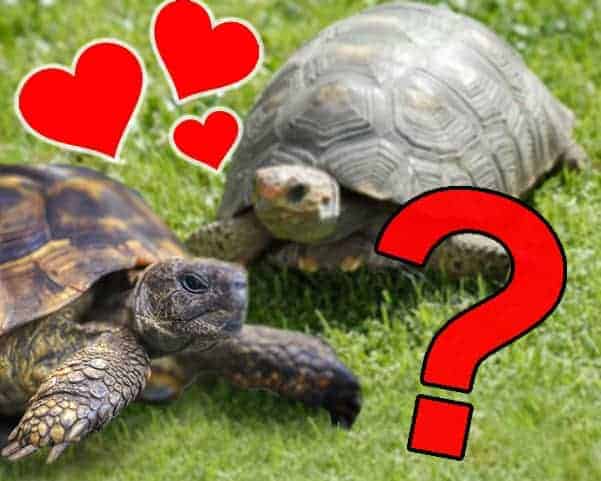
Okay, so I know what you’re thinking, why would you possibly want to crossbreed tortoises? Well for the most part you definitely wouldn’t, however it’s an interesting hypothetical question, so let’s dive a little deeper into this subject.
Tortoises can theoretically interbreed among different species, however allowing or encouraging such behaviour is not advised. The resulting offspring may suffer health issues and will likely be unable to reproduce. On the other hand, closely related species that are genetically similar can breed successfully.

Thankfully, while possible, it is extremely unlikely that any attempt to crossbreed tortoises would yield any offspring at all. However, ‘unlikely’ is not the same as impossible.
Even more unlikely is the possibility of crossbreeding animals that are even more genetically far removed from one another than different breeds within the same species. For example, turtles, whilst part of the same overall ‘order’ as tortoises are part of a completely different ‘genus’, which is effectively one level above ‘species’ in the taxonomic hierarchy of shelled reptiles.
Why You Shouldn’t Allow Different Species to Interbreed
It might work out okay for dogs and horses/donkeys but tortoises really don’t benefit from interbreeding between genetically different species.
An example of this might be if a South American Red Foot tortoise was encouraged to breed with a mediterranean tortoise. Before you even arrive at the issue of interbreeding, you’ve got the more pressing issue of keeping two species in close confines that require wildly different care and living conditions.
Redfoots are of course a tropical species, requiring high temperatures and humidity all year round, not to mention a certain amount of protein in their diet, whereas mediterranean species require a drier climate, temperature that varies to the point at which it is low enough for them to hibernate for several weeks or months of the year, and a diet that includes almost zero animal protein.
So as if the living arrangements weren’t enough of a recipe for disaster, it doesn’t take a lot to imagine what kind of health issues the offspring of such vastly incompatible tortoises might have.
And it’s not just the offspring you need to be concerned about; the difference in size alone can mean that a smaller female impregnated by the sperm of a male from a larger species can result in dangerously large eggs forming inside the female, with potentially fatal consequences.
Cross Breeding That Isn’t Really Cross Breeding
There are some instances where cross breeding is safe to attempt without any negative consequences, although this doesn’t amount to true cross breeding, rather variations within the same species.
Perhaps the best example of this is with the three popular South American species; Red Foot, Cherry Head, and Yellow Foot tortoises. These species are very closely related, and examples of them successfully interbreeding have been reported.
However I should caveat this with the fact that because they appear so similar it can be hard to prove that a hatchling that is apparently the direct descendant of a Red Foot and Cherry Head or Yellow Foot.
Remember female tortoises can store sperm from several points of origin inside them for several months prior to being impregnated, so determining the true paternity of a hatchling can be tricky without genetic testing to prove it.
Cross Breeding Tortoises Back From Extinction
Perhaps one of the most exciting and facinating applications of cross breeding among tortoises is the possibility to ‘ resurrect’ species that are believed to be extinct with the use of carefully (and scientifically) managed cross breeding.
The Galapagos islands are of course famous for being the home of the worlds largest tortoises, of which 15 sub species once existed across the islands. The differences between these sub species were incidentally noted by famed naturalist and pioneer of evolutionary theory Charles Darwin.
During the earliest years of the exploration of the Galapagos many of these tortoises were hunted to extinction, usually for their meat.
However thanks to the genetic similarities between the giant tortoise breeds, in recent years attempts have been made to bring back now extinct sub species by careful breeding of some of the subspecies still in existence.
Given the longevity of these animals and the fact that it might take several generations in order to achieve a tortoise of the same genetic makeup as the extinct subspecies, it might take some time before we are able to inspect the results of this breeding programme!



